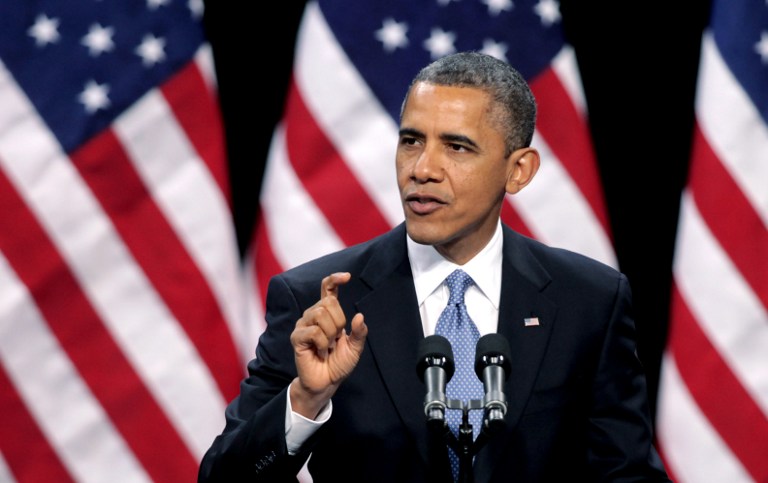SUMMARY
This is AI generated summarization, which may have errors. For context, always refer to the full article.

WASHINGTON, D.C. – To Republican mockery, President Barack Obama rolled out a $3.77 trillion budget Wednesday that laid out his battle lines in a new fiscal showdown in Washington but irked some liberal allies.
Obama said his blueprint for fiscal year 2014 would shield the middle class by closing tax loopholes that help the rich, would grow the economy, cut the deficit, train future American workers and protect seniors.
“For years, the debate in this town has raged between reducing our deficits at all costs and making the investments necessary to grow our economy,” Obama said on an unseasonably warm morning in the White House Rose Garden.
“This budget answers that argument, because we can do both. We can grow our economy, and shrink our deficits.”
Republicans however immediately rejected Obama’s plans. Senate Minority Leader Mitch McConnell branded them as a “left wing wish list.”
House Speaker John Boehner, who has already passed a Republican budget that slashes spending, warned that Obama had already made life tough enough on the rich, adding: “we don’t need to be raising taxes on the American people.”
Obama’s spending plan for 2014 is in many ways an academic exercise, given that it has no chance of being fully enacted in stalemated Washington.
But it will stand as his entry in the latest fast-building showdown pitching the president’s plan to hike taxes on the most well off against Republican plans to slash government spending with no new revenues.
“We don’t view this budget as a starting point. This is an offer where the president came more than half way towards the Republicans in an attempt to get a fiscal deal,” said a senior White House official.
“Are Republicans going to be willing to come to us?” the official asked, ahead of the unveiling of the budget at a time hope has faded for a “grand bargain” deal on the deficit between Obama and Republicans.
The blueprint included one key concession to Republicans, which has already angered elements of Obama’s liberal Democratic base.
Obama signaled he is ready to modify some cherished entitlement social programs, by adjusting cost of living adjustments that could trim benefits for some senior citizens.
The move, ahead of a second dinner between Obama and Republicans at the White House later Wednesday, was intended to try to lure some support for cross party budget and deficit talks.
The White House is billing the budget as a document which proves that the need to cut voluminous deficits does not need to be achieved by savage cuts in government spending and social programs envisaged by Republicans.
Officials say the plan includes $1.8 trillion of deficit reduction over 10 years and would raise $580 billion dollars in new revenue by curbing income tax breaks for the rich, without raising rates.
It would raise the tax on a pack of cigarettes from $1.01 to $1.95 per pack to finance an early childhood education scheme.
The budget would also provide $1.65 billion for the Global Fund to Fight AIDS, Tuberculosis and Malaria and $4 billion to allow security upgrades following the attack on the US consulate in Benghazi last September.
Republicans dispute Obama’s deficit reduction figures, arguing that since the budget would dispense with $1.2 trillion in automatic spending cuts, which began in March and are known as the sequester, its real deficit reduction figure would only be $600 billion in savings.
Among measures that had already been opposed by Republicans, the Obama budget would implement the “Buffett Rule,” which would mandate that households making more than a million dollars a year pay at least 30 percent of income in taxes.
The budget foresees a deficit of $744 billion, or 4.4 percent of GDP, in 2014 — down from a projected deficit of $973 billion this year.
Officials projected that the shortfall would reach 2.8 percent of GDP by 2016 and 1.7 percent by 2023.
The plan assumes unemployment will average 7.2 percent next year, down from the current 7.6 percent.
Economic growth meanwhile is predicted to pick up to 3.2 percent next year, from 2.3 percent this year.
The White House says that the plan represents more than two dollars in spending cuts for every one dollar of new revenue accrued from closing tax loopholes.
It also includes $400 billion in health savings that administration officials say could be found by cracking down on fraud. – Rappler.com
Add a comment
How does this make you feel?
There are no comments yet. Add your comment to start the conversation.